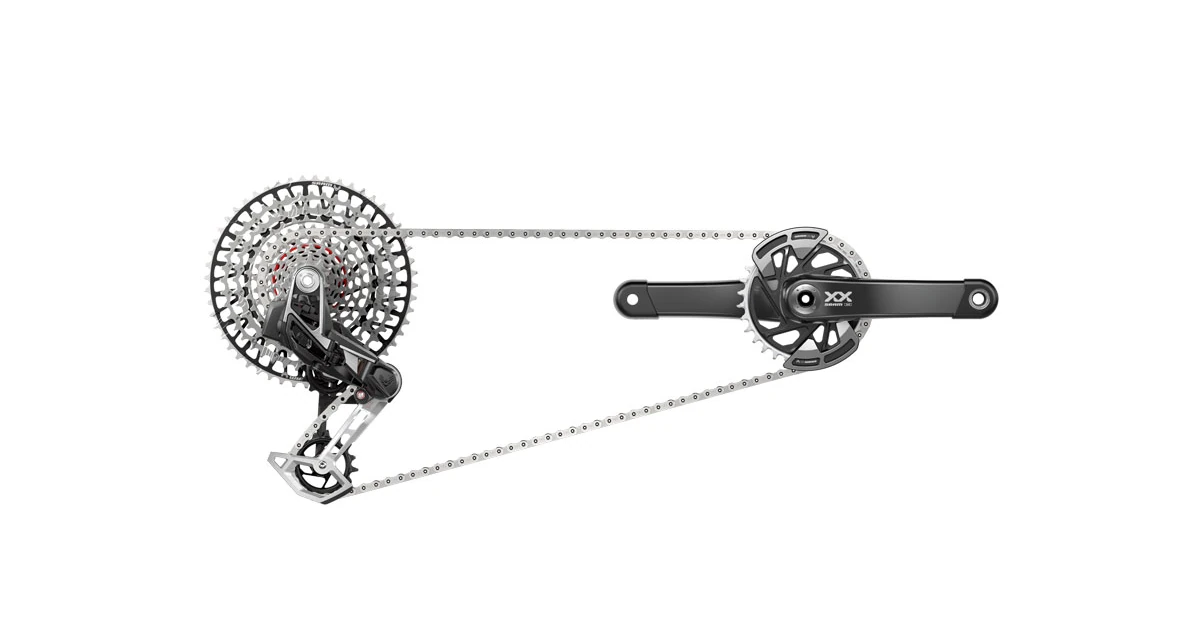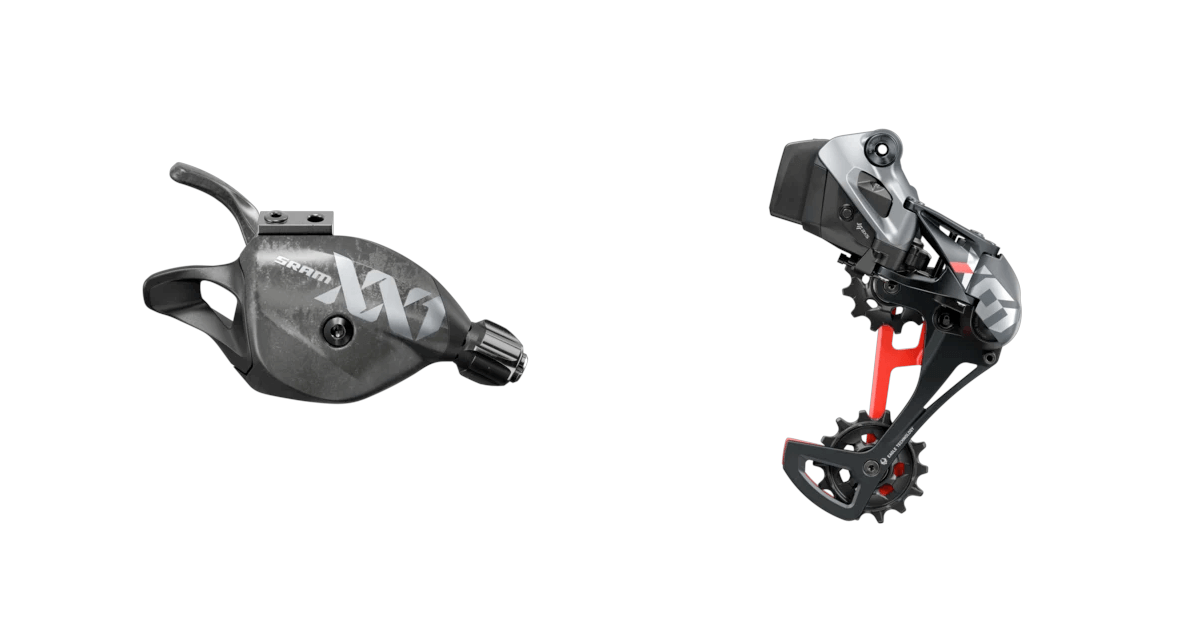Overview and Specifications of WheelTop's Affordable Electronic Groupset "EDS"
This article summarizes the features and specifications of the budget-friendly electronic groupset "EDS" newly released by the Chinese manufacturer WheelTop.
Modified at: Mar 28, 2025
Posted at: Apr 9, 2024
A detailed explanation of compatibility between SRAM MTB components. This guide outlines which parts can be used together and which combinations are not compatible.

Table of contents
Sponsored Link
SRAM’s mountain bike components are divided into three main collections:
When the Eagle Collection was first introduced, all SRAM MTB components were unified under the Eagle name. However, with the launch of the Eagle Transmission Collection in 2023 — which is dedicated to wireless electronic shifting — compatibility across systems is now split.
For a detailed breakdown of SRAM’s MTB component lineup and grading system, check out the article below:

SRAM Component Grades and Compatibility Summary for MTB
This section summarizes the grades, features, and compatibility of SRAM's Eagle series of components for MTB, as well as the electric component AXS and the latest component, Eagle Transmission.
SRAM’s MTB component compatibility is refreshingly straightforward:
The main factors to watch for are:
As long as those match, components across different grades can be mixed and matched freely.
SRAM’s MTB brakes are independent of drivetrain systems. This means any SRAM brake system can be used with any SRAM drivetrain, regardless of the group or shifting method.
Except for the newly introduced “Eagle Transmission,” all grades within SRAM’s Eagle collection are fundamentally cross-compatible.
This means you can freely mix and match components from different Eagle series.
For example, you can pair a GX Eagle crankset with an X01 Eagle derailleur and an NX Eagle chain—allowing you to customize your setup based on your riding style and budget.
THE FREEDOM TO MIX THE FREEDOM TO MATCH
Eagle is a drivetrain ecosystem with more range than ever before. XX1, X01, GX, NX and SX Eagle share technologies that make them all cross compatible.
In other words, you can partially upgrade components from entry-level SX Eagle to higher-end models, or even switch to an electronic shifting system.
However, when upgrading to an electronic setup, you’ll need to replace both the shifter and rear derailleur as a set.
Also, keep in mind that only the higher-end models—XX1, X01, and GX—support a maximum 52T cog.
The NX and SX rear derailleurs are not compatible with a 10-52T cassette.
2021 MTB Components COMPATIBILITY MAP | SRAM
The Eagle collection allows for shared use of chains and cassettes between mechanical and electronic drivetrains, and since AXS components are completely wireless, you can upgrade to an electronic shifting system simply by replacing the rear derailleur and shifter on your existing Eagle setup.
The most affordable electronic drivetrain in the Eagle AXS series is the GX Eagle AXS, which is available as a “GX Eagle AXS Upgrade Kit.”
This kit offers a cost-effective way to electrify your drivetrain without replacing the entire system.
The Eagle Transmission collection uses a different standard from the original Eagle collection, including the chain and cassette, so you can’t mix or partially upgrade from Eagle to Eagle Transmission components.
| Series | Chain | Cassette |
|---|---|---|
| Eagle | 12s Eagle | XG |
| Eagle Transmission | 12s T-Type | XS |
Reference: AXS COMPONENT COMPATIBILITY | SRAM
While the Eagle Transmission series initially launched as an electronic-only drivetrain, SRAM introduced mechanical versions (EAGLE 90 / EAGLE 70) in March 2025.
Naturally, you cannot mix mechanical and electronic parts even within the same Eagle Transmission series.
Shifters and derailleurs must match in type (either mechanical or electronic).
However, cranks, chains, and cassettes within the Eagle Transmission series are cross-compatible regardless of shifting type.
Although older SRAM components were once rumored to be compatible with Shimano, the current Eagle collection is not compatible with Shimano drivetrains.
That said, SRAM offers cassettes compatible with Shimano freehub bodies, meaning some Shimano wheels can still be used with Eagle components.
Choosing SRAM MTB Sprockets: Compatibility and Key Considerations
SRAM components are being increasingly adopted in entry-grade MTB. In this issue, we summarize SRAM's sprockets for MTB and points to consider when choosing one.
Sponsored Link
Overview and Specifications of WheelTop's Affordable Electronic Groupset "EDS"
This article summarizes the features and specifications of the budget-friendly electronic groupset "EDS" newly released by the Chinese manufacturer WheelTop.
What Is Shimano Shadow RD? Features and Benefits
What is Shimano’s Shadow RD used in their latest rear derailleurs? This article explains its features and the benefits of choosing Shadow RD.
[MTB / Hybrid Bike] Hydraulic Brake Manufacturers for Flat Bars
An overview of manufacturers that produce hydraulic brakes for flat-bar MTB and hybrid bikes, along with their key features. Also includes tips on how to choose the right flat-bar hydraulic brake brand.
Shimano Chain Compatibility for Road, MTB, and Hybrid Bikes
An overview of Shimano chain compatibility across road bikes, mountain bikes, and hybrid bikes. Includes guidance on how to choose the right chain for your drivetrain.
Shimano ESSA Lineup and Compatibility with Existing 8-Speed Parts
An overview of Shimano's newly released 8-speed component group "ESSA" and its compatibility with existing 8-speed parts.
SRAM Cassette Compatibility Guide
Compatibility guide for SRAM cassettes used in road and MTB bikes. Find matching drivetrains and wheels easily.
Road and MTB Sprockets Compatibility Overview
A guide to the compatibility between road and MTB sprockets, explaining whether they can be used together with different components.
Types of Shimano Di2 Tools and Their Compatibility
A guide to the essential Shimano Di2-specific tools, especially the "plug tools" used for connecting components, and their compatibility with various Di2 parts.
Shimano CUES Cassette Compatibility Guide
A detailed guide to the compatibility of Shimano CUES series cassettes. Includes an overview of compatible rear derailleurs, chains, and wheels.
Shimano Hydraulic Brake Hose and Connector Standards Guide
An explanation of the differences between Shimano’s hydraulic brake hoses BH90 and BH59, the types of connecting bolts, and how to choose the right hose for your brake system—including key points to watch out for.
[By Manufacturer] Types, Features, Pros and Cons of Hydraulic Brake Oils
This article explains the types of hydraulic oils used in bicycle hydraulic brakes, their characteristics, and the brake oil types used by each manufacturer.
Types and Compatibility of Shimano Di2 Batteries
The Di2 battery is the core of the Shimano Di2 system, influencing the overall system layout. This article explains the different types and their compatibility.
Shimano Di2 Wire Types and Compatibility
Overview of Shimano Di2 electric wire types and their compatibility with Di2 components.
How to Identify Shimano Di2 Generations
Explains the generational differences in Shimano Di2 components and their compatibility. Includes a list of component series and their corresponding generations.
In-Depth Guide to Shimano 12-Speed Cassette Compatibility
A detailed explanation of the key compatibility factors when using Shimano's 12-speed cassettes—specifically the required wheel (freehub) and drivetrain, which differ significantly from previous 11-speed systems.
Perfect Guide to Shimano 11-Speed Cassette Compatibility
A detailed explanation of two key compatibility factors when using Shimano 11-speed cassettes: the required wheel (freehub) and drivetrain.
Perfect Guide to Shimano 10-Speed Cassette Compatibility
A detailed explanation of two key compatibility factors when using Shimano 10-speed cassettes: the required wheel (freehub) and drivetrain.
In-Depth Guide to Shimano 9-Speed Cassette Compatibility
A comprehensive explanation of two key compatibility factors when using Shimano 9-speed cassettes: the required wheel (freehub) and drivetrain.
What Is a BOOST Crank? Differences from Standard MTB Cranks and How to Choose
This article explains what a BOOST crank is, how it differs from conventional MTB cranks, and provides guidance on selection across different manufacturers.
How to Identify Bottom Bracket (BB) Types and Choose Replacement Parts for Road and MTB Bikes
Among road and MTB bike components, bottom brackets (BBs) can be especially difficult to match with replacement parts. This article explains how to identify BB types and how to choose the right replacement parts.